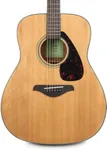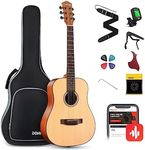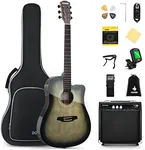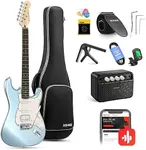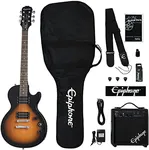Buying Guide for the Best Guitars For Beginners
Choosing your first guitar is an exciting step in your musical journey. The right guitar can make learning easier and more enjoyable, while the wrong one might make it harder to progress. When picking a beginner guitar, it's important to focus on comfort, playability, and suitability for the style of music you want to play. Understanding the key features will help you make a choice that keeps you motivated and helps you develop good playing habits.Type (Acoustic vs. Electric)The type of guitar you choose—acoustic or electric—will shape your learning experience. Acoustic guitars produce sound naturally and are great for learning chords and finger strength, while electric guitars are easier to press and can be quieter with headphones. If you love rock or blues, an electric might inspire you more, but if you prefer folk or singer-songwriter styles, an acoustic is a classic choice. Think about the music you want to play and where you'll practice most often to guide your decision.
Body Size and ShapeGuitars come in various body sizes and shapes, which affect comfort and sound. Smaller bodies are easier to hold, especially for younger players or those with smaller hands, while larger bodies produce a fuller sound but can be bulky. Try holding different sizes to see what feels comfortable, as a guitar that fits your body will make practicing much more enjoyable and less tiring.
Neck Profile and WidthThe neck profile refers to the shape and thickness of the guitar's neck, while the width is how wide the neck is at the nut (the top of the fretboard). Thinner necks are easier for small hands, while wider necks can give more space between strings, which some beginners find helpful. If possible, try a few guitars to see which neck feels easiest for your hand to wrap around and move along.
String Type and GaugeGuitars use either steel or nylon strings, and the thickness (gauge) of the strings can vary. Nylon strings are softer and easier on the fingers, making them a good choice for classical or flamenco styles and for those with sensitive fingertips. Steel strings are brighter and louder, common on most acoustic and electric guitars, but can be tougher on new fingers. Lighter gauge strings are easier to press but may sound less full, while heavier gauges are harder to play but offer richer tone. Beginners often start with lighter strings for comfort.
Action (String Height)Action is the distance between the strings and the fretboard. Lower action makes the guitar easier to play, as you don't have to press as hard, but if it's too low, you might get buzzing sounds. Higher action can be harder on your fingers but may produce a cleaner sound. For beginners, a guitar with medium to low action is usually best, as it balances comfort and sound quality.
Tuning StabilityTuning stability refers to how well a guitar stays in tune after playing or adjusting the strings. Beginners benefit from a guitar that holds its tuning well, as constant retuning can be frustrating and slow down learning. Look for guitars with good quality tuning pegs and a well-made nut and bridge, as these parts help keep the guitar in tune longer.
WeightThe weight of a guitar can affect how long you can comfortably play, especially for younger players or those with smaller frames. Lighter guitars are easier to hold and practice with for extended periods, while heavier guitars may offer a different sound but can be tiring. Pick a guitar that feels manageable for your body size and strength.
